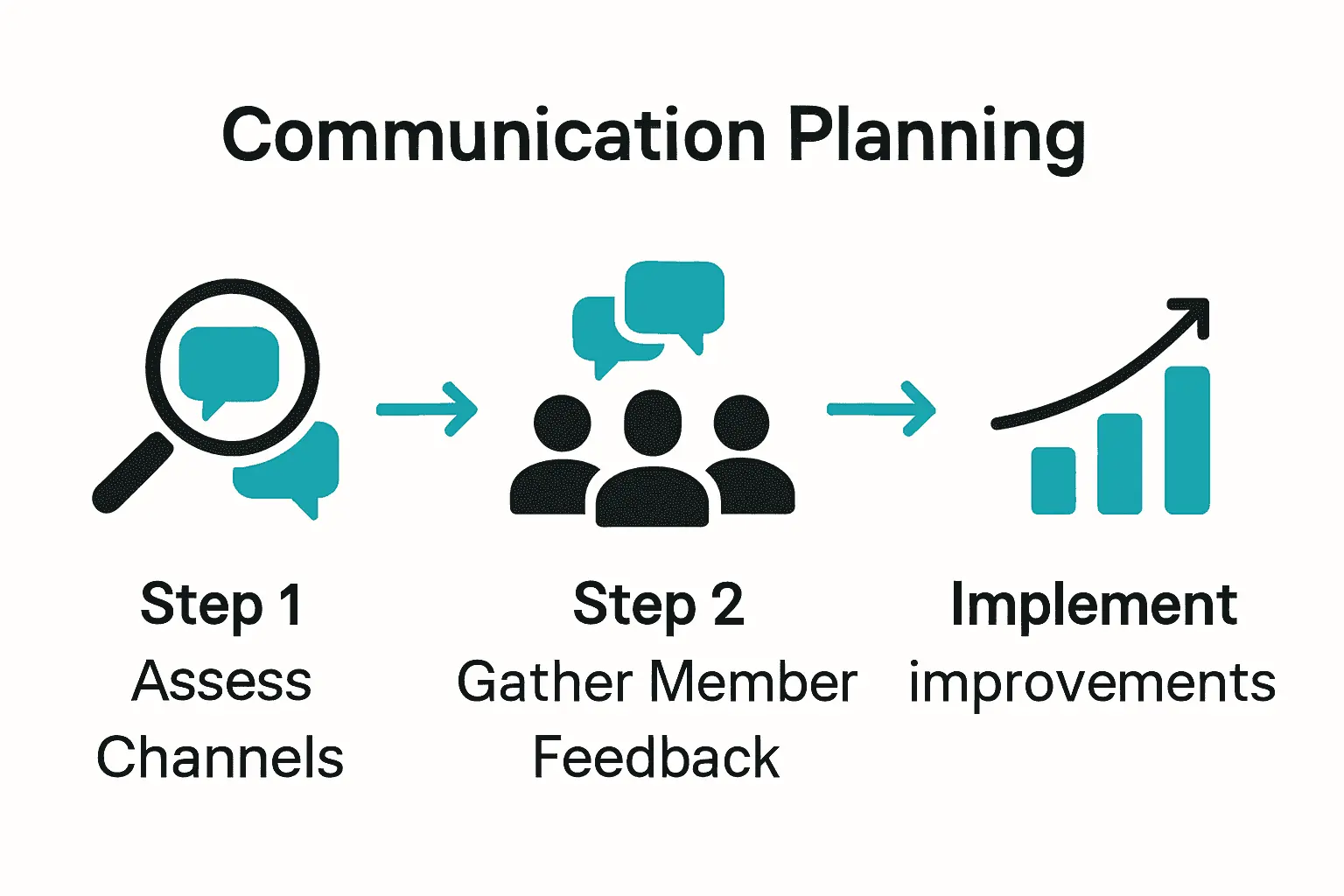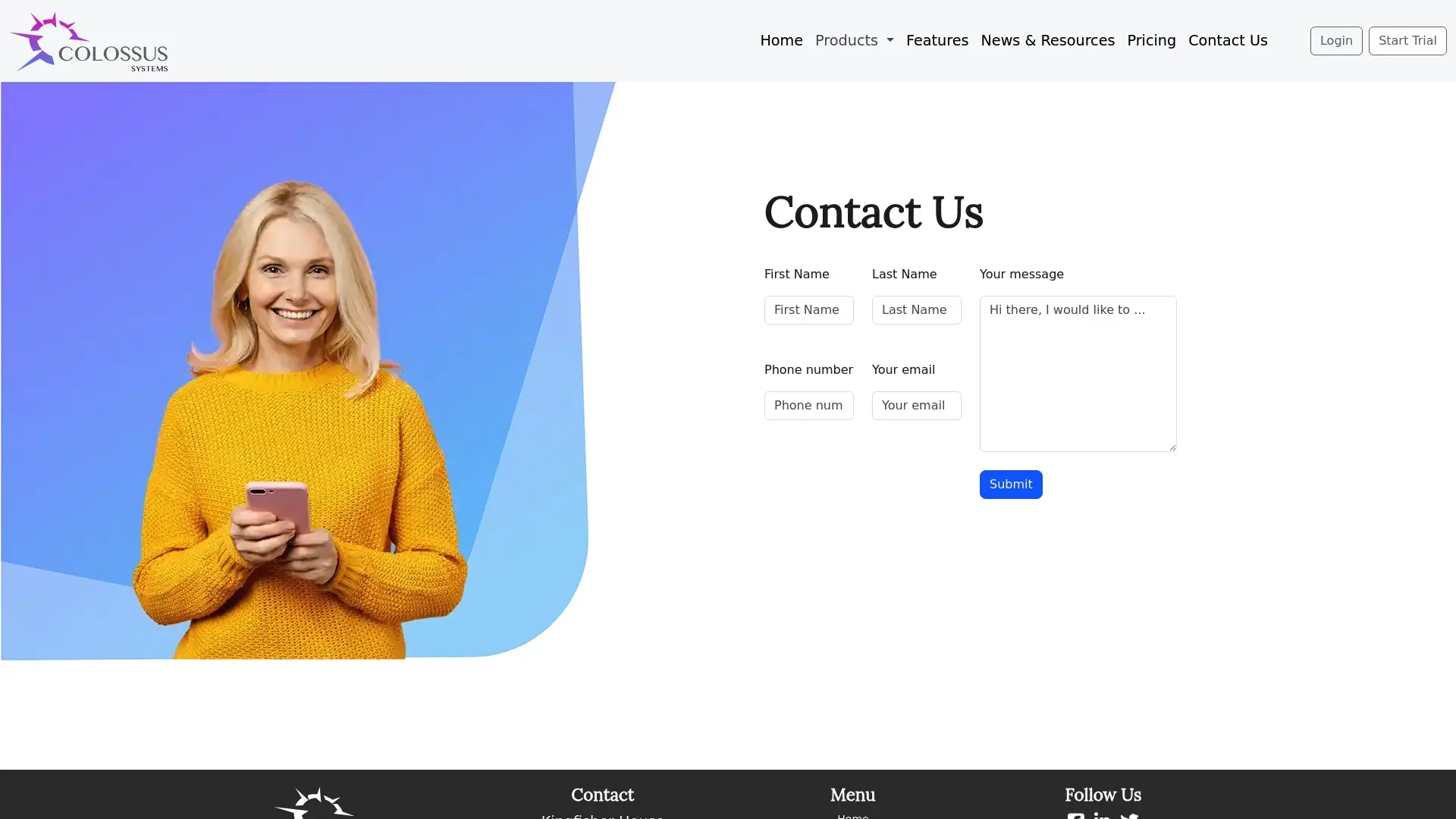Effective Communication Tips for Membership Organizations

Over half of membership organizations struggle to keep members engaged using outdated communication methods. Clear and responsive communication is at the heart of growing trust and participation, yet many groups overlook how members actually prefer to connect and receive information. By exploring practical steps to refine your communication channels, understand member needs, and use proven tools, you can build stronger, more effective relationships with your community.
Table of Contents
- Step 1: Assess Current Communication Channels
- Step 2: Identify Member Needs And Preferences
- Step 3: Craft Clear And Consistent Messages
- Step 4: Leverage Multi-Channel Communication Tools
- Step 5: Monitor Engagement And Gather Feedback
Quick Summary
| Key Point | Explanation |
|---|---|
| 1. Assess your current channels | Evaluate existing communication methods to identify strengths and weaknesses in engaging members effectively. |
| 2. Gather member preferences | Use surveys and focus groups to understand members’ needs and preferred communication styles for better targeting. |
| 3. Create clear, consistent messages | Ensure communication uses simple language and a uniform tone across all channels for better comprehension. |
| 4. Utilize multiple communication platforms | Employ a diverse mix of channels to reach members where they are most comfortable for enhanced engagement. |
| 5. Monitor engagement and gather feedback | Regularly track member interactions and satisfaction to adapt strategies according to their evolving needs. |
Step 1: Assess Current Communication Channels
Assessing your membership organization’s current communication channels is a critical first step in developing a robust communication strategy. In this stage, you will systematically evaluate how your organization currently connects and shares information with members.
Research from openscholar highlights the importance of understanding existing communication methods, noting that organizations like local municipalities often rely heavily on committee meetings and face-to-face interactions. To begin your assessment, create a comprehensive inventory of all current communication channels your organization uses.
Start by mapping out your existing communication tools such as:
- Email newsletters
- Phone communication systems
- Social media platforms
- Member management portals
- Physical mailing lists
- Internal messaging systems
- Website contact forms
- Event communication channels
As noted in research from gphjournal, carefully evaluate the efficiency of each channel. Ask critical questions: How responsive are these channels? What is the average response time? Are members consistently engaging with the content?
To gain deeper insights, consider conducting a brief member survey to understand their communication preferences. Ask about which channels they find most useful, least intrusive, and most informative. This direct feedback will be invaluable in refining your communication strategy.
Warning: Avoid assuming all channels work equally well. Just because a communication method has been used historically does not mean it remains the most effective approach. Be prepared to adapt and evolve your communication strategy based on the data you collect.
Once you have mapped and evaluated your current communication landscape, you will be ready to identify gaps, redundancies, and opportunities for improvement in the next phase of your strategic communication planning.
Step 2: Identify Member Needs and Preferences
Identifying your membership organization’s specific needs and preferences is a crucial step in creating a targeted and effective communication strategy. This process involves deep listening and strategic data gathering to understand what truly matters to your members.
Research from asaecenter highlights the importance of understanding shifting member roles and anticipating future needs. To begin this process, you will create a comprehensive strategy for gathering member insights.
Consider implementing multiple methods to capture member preferences:
- Online surveys with specific and open ended questions
- Focus group discussions
- One on one interviews with member representatives
- Analysis of past engagement data
- Feedback collection during events and meetings
According to guidance from asaecenter, preliminary work is essential. Start by reviewing existing member data to create responsive assessment tools that accurately capture member wants and expectations.
Your survey and research should explore key areas such as:
- Professional development interests
- Preferred communication channels
- Event and networking preferences
- Current challenges in their industry
- Expectations from the membership organization
Warning: Avoid creating surveys that are too long or complex. Members are more likely to provide honest feedback when questionnaires are concise and focused. Aim for surveys that can be completed in 10 minutes or less.
For deeper insights into member satisfaction, consider exploring our Proven Strategies for Improving Member Satisfaction which can provide additional context for interpreting your research findings.
Once you have gathered and analyzed member preferences, you will be prepared to develop a more targeted and responsive communication approach that truly meets your members needs.

Step 3: Craft Clear and Consistent Messages
Crafting clear and consistent messages is fundamental to effective communication in membership organizations. Your goal is to develop communication that resonates with members while maintaining a uniform voice and message across all channels.
According to guidance from aceaglobal, using structured communication channels like emails and newsletters is critical for sharing updates and announcements effectively. This means developing a communication strategy that ensures your messages are not just sent but truly understood.
Key principles for creating clear messages include:
- Use simple and direct language
- Avoid unnecessary jargon or complex terminology
- Maintain a consistent tone across all communications
- Provide context for important announcements
- Use formatting to improve readability
Research from ctb emphasizes the importance of involving stakeholders to ensure messages resonate with your audience. This means understanding your members communication preferences and tailoring your approach accordingly.
Develop a communication style guide that outlines:
- Preferred writing tone
- Acceptable vocabulary
- Formatting standards
- Visual branding guidelines
- Approved communication templates
Warning: Inconsistent messaging can confuse members and undermine your organization’s credibility. Ensure all team members understand and follow your communication guidelines.
To help refine your approach, explore our Improving Member Engagement Strategies for additional insights into creating compelling communication.
Once you have established clear and consistent messaging protocols, you will be well positioned to create communications that inform engage and inspire your membership community.
Step 4: Leverage Multi-Channel Communication Tools
Leveraging multi-channel communication tools is essential for reaching and engaging your membership organization effectively. This approach ensures you connect with members through their preferred communication platforms and maximize your outreach potential.
According to guidance from aceaglobal, utilizing a diverse mix of communication channels including emails newsletters and websites is crucial for effectively reaching and engaging association members.
Consider implementing these communication channels:
- Email newsletters
- Social media platforms
- Organizational website
- Mobile app notifications
- Physical mail
- Video conferencing platforms
- Online member portals
- SMS text messaging
- Virtual event platforms
Research from ctb advises using various communication methods to engage different stakeholders ensuring messages remain accessible and effective across diverse groups.
To maximize your multi channel strategy consider these implementation tips:
- Match communication channels to member preferences
- Synchronize messaging across platforms
- Track engagement metrics for each channel
- Regularly update communication technologies
- Create platform specific content
Warning: Avoid overwhelming members with excessive communications. Quality and relevance matter more than quantity.
For deeper insights into digital communication strategies checkout our comprehensive Digital Communication Strategies for Member Organisations which provides advanced techniques for effective member engagement.
Once you have established a robust multi channel communication approach you will be well positioned to create a more connected and engaged membership community.
Step 5: Monitor Engagement and Gather Feedback
Monitoring engagement and gathering feedback are critical processes for understanding and improving your membership organizations performance. These activities provide valuable insights into member satisfaction retention and potential areas of growth.
Research from asaecenter highlights the importance of analyzing disruptive forces affecting members and suggests that continuous engagement monitoring is crucial for developing a responsive membership strategy.
Key methods for monitoring engagement include:
- Tracking attendance at events and webinars
- Measuring email open and click through rates
- Analyzing website and member portal interactions
- Reviewing social media engagement levels
- Monitoring member renewal rates
To effectively gather meaningful feedback implement these strategies:
- Create periodic member satisfaction surveys
- Conduct one on one interviews with representative members
- Host focus group discussions
- Use net promoter score assessments
- Implement quick pulse surveys after events
Warning: Feedback collection is only valuable if you demonstrate that you are listening. Always communicate how member input translates into tangible organizational improvements.
For more detailed insights into measuring member engagement our comprehensive Engagement Metrics Explained Guide provides advanced techniques for understanding your membership dynamics.
By systematically monitoring engagement and proactively gathering feedback you will create a dynamic responsive organization that continuously adapts to meet your members evolving needs.

Transform Your Membership Communication with Colossus Systems
Effective communication is the backbone of any thriving membership organisation. If you found yourself reflecting on how to assess current channels, identify member preferences or craft clear and consistent messages in the article, you are not alone. Many organisations struggle with the challenge of juggling multiple communication platforms while striving to engage members meaningfully. The pain of inconsistent messaging, low engagement rates, and feedback that gets lost can feel overwhelming but it does not have to be this way.

Colossus Systems offers a powerful SaaS platform designed to unify your member management, email marketing, event planning and CRM all in one place. This means your organisation gains the ability to tailor communication channels precisely to member preferences uncovered during your assessments while monitoring engagement in real time. With our highly customisable tools, you can streamline multi-channel messaging and track interaction metrics effortlessly ensuring your voices remains clear, consistent and impactful. Ready to stop guessing and start growing with data-driven communication strategies? Connect with us today by visiting Contact Us and discover how the right platform can elevate your member experience. Explore Proven Strategies for Improving Member Satisfaction and Digital Communication Strategies for Member Organisations to see why so many membership groups trust Colossus Systems for their growth.
Frequently Asked Questions
How can I assess my membership organization’s current communication channels?
Assess your organization’s communication channels by creating a comprehensive inventory of all methods currently in use. Map out tools like email newsletters, social media, and internal messaging systems. Analyze their responsiveness and member engagement within 30 days to identify areas for improvement.
What are effective ways to gather member feedback on their communication preferences?
Utilize online surveys, focus group discussions, and one-on-one interviews to gather meaningful feedback from members about their communication preferences. Aim for concise surveys that take no longer than 10 minutes to complete, allowing you to analyze their responses promptly.
How can I create clear and consistent messages for my members?
To craft clear messages, use simple language and maintain a consistent tone across all communication channels. Develop a communication style guide that outlines writing tone, acceptable vocabulary, and formatting standards to ensure uniformity within 60 days.
What multi-channel communication tools should I use to engage my members?
Incorporate a mix of communication tools such as email newsletters, social media platforms, and online member portals to reach your members effectively. Monitor member engagement on each channel regularly to improve your strategy continuously.
How do I monitor member engagement effectively?
Track key metrics such as email open rates, attendance at events, and social media interactions to monitor member engagement. Set a routine to analyze these metrics quarterly to identify trends and areas for further engagement.
What steps should I take after gathering member feedback?
After gathering feedback, communicate how member input translates into organizational improvements. Create a plan for implementing changes within the next 90 days and share updates with members to demonstrate that their voices matter.